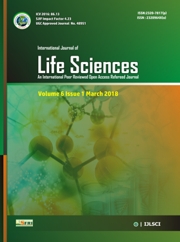RESEARCH ARTICLES
Volume 8 |Issue 4| July-August 2020 First published: 30 Augest 2020
Isolation and Screening of Cellulase Producing Bacterial
Strain from Meteoritic Crater of Lonar Lake
Umrikar AM and Hamde VS
Department of Microbiology, Yogeshwari Mahavidyalaya, Ambajogai-431517, Dist. Beed (MS) India
Abstract
Keywords:Bacillus Sp., CMC, Lonar lake, Isolates
Editor: Dr.Arvind Chavhan
Cite this article as:
Umrikar AM and Hamde VS. Isolation and Screening of
Cellulase Producing Bacterial Strain from Meteoritic Crater
of Lonar Lake, Int. Res. Journal of Science & Engineering,
2020, Volume 8(4): 141-144.
Copyright:
Open Access This article is licensed under a Creative Commons Attribution 4.0 International License, which permits use, sharing, adaptation, distribution and reproduction in any medium or format, as long as you give appropriate credit to the original author(s) and the source, provide a link to the Creative Commons license, and indicate if changes were made. The images or other third party material in this article are included in the article’s Creative Commons license, unless indicated otherwise in a credit line to the material. If material is not included in the article’s Creative Commons license and your intended use is not permitted by statutory regulation or exceeds the permitted use, you will need to obtain permission directly from the copyright holder. To view a copy of this license, visit http://creativecommons.org/ licenses/by/4.0/
References
1. Kanekar PP, Joshi AA, Kelkar AS, Borgave SB and Sarnaik SS. Alkaline Lonar Lake, India- A treasure of alkaliphilic and Halophilic bacteria, Proceedings of Taal2007: 12th world lake Conference, 2008, 1765-1774.
2. María De Lourdes Moreno, Dolores Pérez, María Teresa García And Encarnación Mellado. Halophilic Bacteria as a Source of Novel Hydrolytic Enzymes, Life, 2013, 3, 38-51.
3. Ashabil Aygan, Lutfiye Karcioglu and Burhan Arikan. Alkaline Thermostable and Halophilic Endoglucanasefrom Bacillus licheniformis C108, African Journal of Biotechnology, 2011, Vol. 10(5), pp. 789-796.
4. Jeong-Hwa C, Wan-Taek I, Qing-Mei L, Jae-Soo Y, Horikoshi K. Alkaliphiles: some applications of their products for biotechnology. Microbiol Mol Biol Rev.,1999, 63:735–750.
5. Siddarthan Venkatachalam, Manivannan Sivaprakash, Vasudevan Gowdaman And Solai Ramatchandirane Prabagaran. Bioprospecting Of Cellulase Producing Extremophilic Bacterial Isolates From India, British Microbiology Research Journal, 2014, 4(2): 138-150.
6. Bancy N. Muruga and Beatrice Anyango (2012), A Survey of Extremophilic Bacteria In Lake Magadi, Kenya, Columbia International Publishing American Journal Of Molecular And Cellular Biology , 2013, 1: 14-26.
7. Kshipra B. Deshmukh, Anupama P. Pathak, Mohan S. Karuppayil. Bacterial Diversity of Lonar Soda Lake Of India. Indian J Microbiol, 2011, 51(1):107–111.

